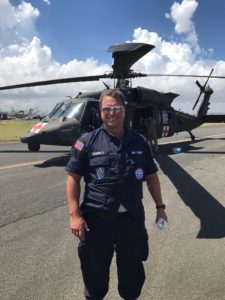Dr. Erik Schobitz Travels To Post-Hurricane Florida and Puerto Rico

As Hurricane Irma barreled toward Florida as a Category 5 storm, the nation’s emergency response and the media kicked into high gear. The extensive damage from Hurricane Harvey in Houston seemed to have caught everyone off-guard, and no one wanted to make the same mistake twice. Dr. Erik Schobitz, a pediatric emergency physician with US Acute Care Solutions and an Army veteran who had served as an Infantry Battalion Surgeon in the 2003 Iraq invasion, stood ready to help.
Eight years ago, Schobitz helped start Maryland’s Disaster Medical Assistance Team, known as a DMAT (pronounced Dee-Mat). Many states have one, and some larger states have multiple DMATs. “It’s similar to the reserves, except there’s no gun,” Schobitz said. Anyone can join a DMAT, but they are predominantly made up of first responders, medical providers, and former military like Schobitz. When he got out of the army, Schobitz joined up with one as an outlet to continue serving his country. Then he helped form the Maryland chapter, which now has around 80 members.
When DMATs gets activated, their medical licenses and malpractice insurance are nationalized for the duration of the deployment. In the case of Hurricane Irma, Schobitz sought two weeks off from working shifts at Shady Grove Adventist in Maryland so that he could he could go help. His colleagues at the hospital were more than ready to help fill the shifts. “They stood for me so I could go stand up in Florida,” Schobitz said.
Only, Florida wasn’t where he was really needed.
Schobitz and the rest of the team boarded a C-17 military transport plane to Orlando. When they arrived, the airport was closed and the power was off. The airport was pitch black except for a few emergency lights. The only hotel nearby capable of handling the influx of so many personnel was the Disney Resort, so Schobitz was put up at Disney’s All Star Sports Resort. He was named Deputy Team Commander, which meant coordinating travel and resources, arranging missions, and ensuring responders were educated for the kinds of care they were likely to encounter.
“We had expected it to be a Katrina-like event but for Florida,” said Schobitz, who has also served in missions after Hurricanes Katrina and Sandy. As it turned out, a much more serious disaster than the one caused in Florida was about to unfold in a U.S. territory a thousand miles to the southeast in the middle of the Caribbean. When Hurricane Maria hit Puerto Rico, it knocked out power to nearly the entire Island and led to slow-moving crisis unprecedented in the island’s history.
“It was supposed to be a two-week deployment, but when Maria hit they asked for volunteers to extend, and that was when the rest of the team [back at AHC Shady Grove Medical Center] stood up and covered more of my shifts.” Schobitz flew from Orlando to Atlanta, but, with only one functional airport in San Juan and most of Puerto Rico’s seaports damaged by the storm, a severe bottleneck prevented Schobitz and his team from flying down. Food, water, and security took precedence over getting medical personnel down there, he said. “The hardest part was the waiting.”
After several days of delay in Atlanta, the DMAT team was finally flown to San Juan. They arrived in the afternoon, and from there Schobitz took an Army Blackhawk helicopter to San Germán. He worked at Hospital de la Concepcion, which was the only functional hospital in all of Southwest Puerto Rico. It had been nearly a week since the hurricane and hardly anyone had electricity. Three weeks later, 80% percent of the island would still remain dark. Puerto Rico’s fragile infrastructure had simply been overwhelmed by devastation.
Schobitz embedded with the hospital’s staff and began treating patients. Patient volume was about 20 percent higher than normal, but acuity was much worse. Injuries and ailments ran the gamut: minor traumas, general adult ailments, hand-foot-and-mouth disease, and one gentleman who had slashed his foot open while clearing hurricane debris with a machete. They had to do paper charting in both Spanish in English, and Schobitz said local medical students were made available to translate when needed.
Schobitz and the 36 other providers he’d been deployed with slept on the floor and worked 12 hours a day. The team stayed on until they were relieved by another team several days later. Schobitz said he estimated about 10 DMAT teams had been deployed, with hundreds of medical personnel and thousands of FEMA personnel on top of them.
“They welcomed us with open arms,” Schobitz said of the local hospital staff. “As far as the people on the ground, they were working hard. They were wonderful people. We were grateful to be able to help.”
Editor’s Note: Anyone with an interest in disaster medicine is encouraged to look up their state Disaster Medical Response Team. More information can be found on the National Disaster Medical System website.

